The 7 Most Badass Last Stands in the History of Battle
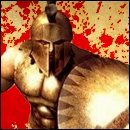
"Let me not then die ingloriously and without a struggle, but let me first do some great thing that shall be told among men hereafter."
- Hector of Troy, Iliad XXII, Lines 304-5
Throughout the course of history, certain individuals have stood out as being completely fucking awesome.
Whether it's cleaving monsters' faces in half with a chainsaw bayonet in Horde Mode, defending a makeshift fortress from a sea of brain-devouring zombies or manning a machine gun nest against an unstoppable sea of charging soldiers; people have always been fascinated with badass stories of one man, by himself, taking on a endless waves of assailants, refusing to back down in the face of insurmountable odds, dying with his fingers still clutching his weapons and leaving behind a smoldering, heaping pile of severed limbs, carnage and dead enemies. These are badass one-man last stands.
Agis III of Sparta, 331 BC

"He ordered the rest to make their escape with all speed and to save themselves for the service of their country, but he himself armed and rising to his knees defended himself, killed some of the enemy and was himself slain by a javelin cast."
- Diodorus, Library of History
When Agis III succeeded his father as King of Sparta in 338 BC, Alexander the Great was off in Persia fighting Emperor Darius III. Figuring it was a good time to fuck some shit up, A3 as he was known in the underground hip-hop scene, rallied anti-Macedonian leaders to his cause, raised a decent army, invaded Crete and started pushing his way towards Athens.

Agis wasn't above petty vandalism to make his point.
Deciding this guy wasn't fucking around, Alexander sent his most battle hardened general and an army of 40,000 men to open a 10-gallon drum of thermonuclear whoop-ass on the Spartans. On the battlefield outside the city of Megalopolis (they just don't name cities like they used to) the two armies faced off in one of the largest battles ever fought between Greek armies in the Classical Age.
Despite being outnumbered roughly two-to-one, Agis wasn't going to back down from any opportunity to drench the tip of his spear in a few gallons of human plasma. Screaming the most horrible profanities they could think of as they went, A3 charged out in front of his men and fought like a goddamned madman, slashing people with his Spartan blades, before receiving a disturbing number of reciprocal wounds across his chest, head and legs.

Figuring he was dead, A3's guards recovered his severely-wounded body, laid him on his shield and began carrying him from the field. Remembering that he was a shit-wrecking King, A3 decided he wasn't going to let a few pesky mortal wounds keep him on the sideline while his army got destroyed.
So he ordered his army to retreat while he held off the onslaught. By himself.
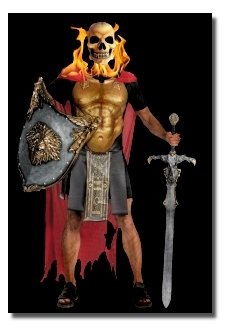
We're pretty sure this is what he really looked like.
Unable to stand and bleeding like a poorly wrapped package from the butcher shop, Agis got to his knees, gripped his blades and proceeded to hamstring enough charging enemy troops to buy his army time to withdrawal. The Macedonians backed off slowly, presumably because they'd just gotten owned by one dude on his knees. Realizing they didn't want to get anywhere near his swords, someone chucked a javelin through his torso, probably catching at least a bit of his enormous balls in the process.
Further Reading:
Livius.org JStor.orgDiodorus. Library of History. Trans. C.B. Wells. Harvard Univ. Press, 1967.
The Cambridge Ancient History. Ed. John Boardman. Cambridge Univ. Press, 1982.
Warry, John. Alexander, 324-323 BC. Osprey, 1991.
Sempronius Densus, 69 AD

"No man resisted or offered to stand up in his defense, save one only, a centurion, Sempronius Densus, the single man among so many thousands that the sun beheld that day act worthily of the Roman empire, who, though he never received any favor from Galba, yet out of bravery and allegiance endeavored to defend the throne."
- Plutarch, Lives
Sempronius Densus was a grizzled old war veteran who took his job as a Roman Imperial Guard very seriously. So he wasn't about to run when he saw a few thousand mutinous Roman soldiers marching on the palace preparing to execute the Emperor. It's important to keep in mind that Densus had no particular loyalties to the Emperor Galba. He just knew that his job description called for him to put his life on the line to save the son of a bitch, and he didn't fuck around when he was on the job. So Densus walked towards the mob, brandishing his Centurion Whacking Stick--a short cudgel that Roman officers used to administer back-breaking corporal punishment to out-of-line soldiers--and ordered the advancing men to stop.
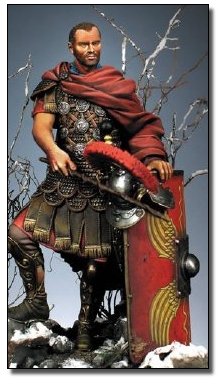
This here's my whacking stick.
Seeing that the blood thirsty, sword carrying mob of 1,000 wasn't listening to the one dude with a stick, Densus pulled his pugio--a short dagger roughly half the size of the standard Roman sword. Thinking that should convey just how much business he meant, Densus once again screamed at them to stop. Again, they kept on marching. Certain that they'd been able to hear him that last time, Densus shrugged, probably said, "You asked for it," and lunged on the posse.

Dead or alive, you're coming with me!
Completely surrounded, Densus fought the entire army by himself to defend a man he hardly knew. Hardened by years of combat, he slashed his way through the army, as Plutarch puts it, "for some time." His courageous stand ended when he was brought down by a blow to the back of the knee and enthusiastically murdered by the mob. Unfortunately for the guy he was guarding, the men operating his carriage were so awestruck by Densus' giant balls that they dropped their gear and ran for it, face-planting the Emperor in the turf. Galba was killed, decapitated and his head was paraded around town on a spear. Plutarch fails to mention what the mob did with Sempronius Densus' body, though we have to imagine it involved very little parading, and a whole lot of staying the hell away. As slasher films would go on to teach us, you should never assume you've actually killed anyone who can kill that many people with just a knife.
Further Reading:
Plutarch. Lives. Trans. John Dryden. Little, Brown, 1905.
Staff, Wellesley K. Year of Four Emperors. Routledge, 2003.
Tacitus. Histories. Kessinger, 2004.
Dian Wei, 197 AD

"The surrounding area littered with many casualties and dead. Dian Wei received over ten cuts, yet he continued to fight despite lacking troops. Dian Wei held onto two traitors underneath his arms, killing them. The remaining traitors dared not to advance any further."
- Chen Shou, Records of the Three Kingdoms
Dian Wei was a monstrous cruise missile of manslaughter, which is something you'd kind of have to be if you were a guy that had a name that was a homophone for "Diane." His skill as a peerless purveyor of battle-raging carnage helped him rise through the ranks of the military of the Kingdom of Wei, until eventually he was hand-selected by the Wei King, a guy named Cao Cao, to serve as his personal bodyguard and the most badass bouncer in Imperial China.

Dian's Last Stand took place during the Battle of Wancheng in 197 AD, when he essentially curbstomped an entire army into submission by himself. Apparently, some local governor had gotten a little pissed off when Cao Cao banged the dude's aunt, and launched a surprise nighttime sneak attack on the Wei King's camp. When the hordes of oncoming warriors approached the gates they found his personal bodyguard standing at the entrance brandishing a hulking pair of 40-pound axes.

Failing to appraise just how ready he was to make them look like the losing end of a bear attack, the would-be assassins charged, and Dian commenced spraying the countryside with distasteful amounts of high-impact blood spatter. After playing giant-axe-whack-a-mole with the unfortunate bastards who reached him first, Wei got super pissed and started cracking spines with his bare hands. He killed at least 20 enemies, perhaps more, before another group of assassins that had entered the building from a different direction attacked him from behind, and he was finally brought down by a rain of blows from every direction.
Dian had achieved his goal however--Cao Cao escaped to fight another day, and ended up almost single-handedly conquering all of China and eventually bringing the Three Kingdoms period to a close.
Further Reading:
Chen Shou. Records of the Three Kingdoms. Trans. Giao Chau.
Dian Wei, 2004.
Guanzhong Luo. Three Kingdoms. Trans. Moss Roberts. Univ. of California Press, 2004.
The Viking at Stamford Bridge, 1066 AD

"But there was one of the Norwegians who withstood the English folk, so that they could not pass over the bridge, nor complete the victory."
- The Anglo-Saxon Chronicle
In 1066, the Vikings took a break from wrecking shit, and got ambushed at a place called Stamford Bridge. The Vikings didn't even have a chance to get their armor on before they noticed a tremendous army of Saxons ready to kick some ass and possibly take names (which they would probably mispronounce).

Only one of the Norsemen was ready for combat--an insane, nameless berserker conjured up from some nightmarish backwater asshole of Hell.
The Saxons, seeing victory was just one frothing-at-the-mouth-berserker away, charged forward to dislodge him. This proved to be a mistake.
In the horrific carnage that ensued, countless Saxon soldiers were transformed into a continuous fountain of gore, his mighty axe blows cleaving shields and helmets like they were made out of deliciously-melty butter. Arrows, spears and swords were useless against him. He seemed incapable of feeling pain, or really any sensation other than an unstoppable mad desire to kill every single person on Earth.
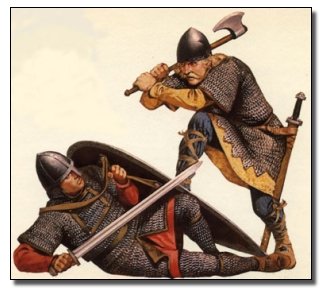
Eventually, one enterprising Saxon warrior figured out that, like any good video game boss, the Viking hero had a weak point. The Saxon went upstream, floated a barrel into the river, jumped in and drifted down towards the bridge. As soon as he was below the scene of the battle, this cowardly douche canoe thrust his spear up between the planks, striking the Viking juggernaut in his lone weak point: the ball sack.
The Viking champion dropped down to his knees, as is to be expected from a guy who just took a piercing blow to the nads, and was subsequently cut down and probably used as firewood.
Further Reading:
Anglo-Saxon Chronicle. Trans. Ingram, Rev. James. Everyman Press, 1912.
Bury, John Bagnell, et al. The Cambridge Medieval History. Macmillan, 1913.
Craughwell, Thomas J. How the Barbarian Invasions Shaped the Modern World. Rockport, 2008.
Furneaux, Rupert. Invasion: 1066. London: Prentice-Hall, 1966.
Saito Musashibo Benkei, 1189 AD

"Benkei stood there defiantly, naginata in hand, and so terrible did he look that none dared approach him."
- Stephen Turnbull, The Samurai: A Military History
The feudal Japanese shit-wrecker, Saito Musashibo Benkei, was a massive, ferocious behemoth of a man, known for being strong enough to pulverize your head into a disgusting grayish mush with his bare hands. If you made it past his reputation with control over your bowels, his hideously ugly and freakishly ogre-like appearance was there to cause opposing warriors to shit their armor.

Benkei was a Buddhist priest, but he wasn't the sort of Buddhist priest that spends all day in his sanctuary praying, thinking about peace and not going around smashing people in the groin with a bladed poleaxe until they cough up their prostate. He joined a monastery, but that was a little too tame for him, and he was eventually kicked out because of his recklessness and general balls-outitude. So instead, he went out and declared a Wookiee Life Debt to the only man capable of defeating him in single combat: the feudal samurai warlord, Minomoto no Yoshitsune.
Things were going pretty well for the pair re: kicking everyone's ass in Japan, until one day Yoshitune's brother decided he was going to take charge, seize power for himself and declare his brother a traitor. Yoshitsune, knowing that the end was near, decided that the only rational way of dealing with the dishonor was to ritualistically disembowel himself by committing seppuku. It takes a little bit of time to do the seppuku thing up right, though, so in his final act as a samurai lord Yoshitsune ordered our man Benkei to guard the castle. While "watching the door while I go kill myself" might not sound like the most sacred of duties, committing seppuku was like blowing oneself up in a cosmic game of Halo in order to deny an opponent the satisfaction of getting the final kill-shot.

It ain't easy to kill yourself with a gun like this.
Benkei went out to the drawbridge leading towards the castle, clenched his naginata in his hands and dared the army on the other side to fuck with him. When a few accepted, Benkei slapped the fail out of them with the blunt end of his bladed axe, knocking their brains out and sending crumpled remains splashing into the moat. The enemy army stood across from him, trying to figure out how the balls they were going to get past, and whenever some dumbshit managed to find the cojones required to step foot on the drawbridge Benkei made sure the last thing he saw was a foot-long hunk of razor sharp steel.

Realizing that any attempts of fighting Benkei like a man were going to result in an eviscerated brain pan, the opposing army just decided to shoot a bunch of arrows at him instead. Amazingly, this didn't even seem to faze him all that much--he just stood there, weapon at the ready, his armor bristling with a couple dozen arrows. It took them a while to realize that he was in fact dead. Legend has it that he died standing, though logic would suggest that some of the arrows he had sticking out of his body might have kept him upright. Either way, by the time anyone had the balls to realize the gatling gun barrage of arrows had killed him it was too late--the proud warrior had already completed the ritual and died with all the honor due a samurai of his stature, or alternately a really obnoxious Halo player.
Further Reading:
De Benneville, James. Tales of the Wars of the Gempei. Bibliobazaar, 2001.
Murasaki Shikibu. Tale of the Heike. Trans. Helen Craig McCullough. Stanford Univ. Press, 1994.
Turnbull, Stephen R. The Samurai: A Military History. Routledge, 1996.
Turnbull, Stephen R. Warriors of Medieval Japan. Osprey, 2007.
Frank Luke, 1918 AD

"Forced to make a landing and surrounded on all sides by the enemy, who called on him to surrender, he drew his automatic pistol and defended himself gallantly until he fell dead from a wound to the chest."
- Medal of Honor citation
Lieutenant Frank Luke of the United States Army Air Service had earned a reputation as a lights-out "balloon buster," which sounds kind of like a lame-ass Atari game but was actually pretty hardcore. Back before the days of UAVs, satellite imaging and Imperial Psykers, artillery spotting and intelligence gathering was usually just obtained by some dude standing around in a hot-air balloon with a pair of 'nocks and a radio. Taking one of these bastards out usually meant you were saving trenchloads of infantrymen. Since the tethered balloons were also relatively-stationary, high-priority targets, they were also usually escorted by fighter squadrons and surrounded by ground-based anti-aircraft batteries, making them pretty tough to get to. So, as lame as the name might be, the guy's job was basically the Death Star trench run at the end of Episode IV with the added bonus that you got to turn an enemy target into the Hindenburg.

Frank Luke: Earth's Luke Skywalker.
He was damn good at it, too--in just 17 days of combat he took out 18 enemy aircraft, including one battle where he shot down two balloons and three fighter planes in the span of 10 minutes. Another time he was on one of his trademark "lone wolf" missions and his gun jammed, so he climbed out, fixed it in mid-flight, turned BACK AROUND, hunted his target down and killed him.
Being such a balls-out deathmeister eventually caught up with Luke, however, and his last stand began in the skies above Murvaux, France in 1918. He was alone, deep behind enemy lines and intent on taking out a large cluster of enemy aircraft and balloons. He started with a low run that barely cleared the tree tops, but handily turned two German observation balloons in to raging airborne infernos. However, while dodging ground fire from anti-aircraft batteries and machine gun towers, a squadron of eight German fighters dove down from above and began pursuing him as well. It was beginning to seem like Frank Luke had gotten in over his head here.

Well, if you know shit about Luke, you know that he wasn't going to piss his pants just because a couple hundred German soldiers were filling the air with more bullets than a Gradius boss battle. Luke continued to press the attack, surrounded on all sides by gunfire, and managed to take out the third and final balloon stationed at this aerodrome.
By this point Luke had been hit by enough gunfire that his plane, and his body were both beginning to fail. Deciding there was time for one final run, and realizing there was nothing left in the sky for him to kill, he picked off six enemy infantrymen before crash-landing in an open field. Luke, never one to show any mercy or ask for quarter, now found himself surrounded on all sided by the heavily-armed German soldiers that were closing in on his position. Badly wounded and in hostile territory, Luke defied authority to the end. When the assembled enemy troops called for his surrender, he responded by unholstering his pistol and picking off a few more Germans. After he died from a chest wound, he became the first member of the USAS to ever receive the Medal of Honor.
Further Reading:
Cooke, James G. United States Air Service in the Great War. Greenwood, 1996.
Guttman, Jon. USAS 1st Pursuit Group. Osprey, 2008.
Hudson, James J. Hostile Skies. Syracuse Univ. Press, 1997.
Roberts, Priscilla Mary. Encyclopedia of World War I. ABC-CLIO, 2005
Thomas A. Baker, 1944 AD

"Another comrade, withdrawing, offered assistance. Sgt. Baker refused, insisting that he be left alone and be given a soldier's pistol with its remaining eight rounds of ammunition. When last seen alive, Sgt. Baker was propped against a tree, pistol in hand, calmly facing the foe. Later Sgt. Baker's body was found in the same position, gun empty, with eight Japanese lying dead before him. His deeds were in keeping with the highest traditions of the U.S. Army."
- Medal of Honor citation
Sergeant Baker was part of a combined Army and Marine Corps expedition to capture the Mariana Island of Saipan from the Japanese. In the days prior to his final stand, when his squad was pinned down by heavy machine gun fire, Baker grabbed a rocket launcher, ran within 100 yards of the Japanese bunker and turned it into cinder-block dust with one shot.
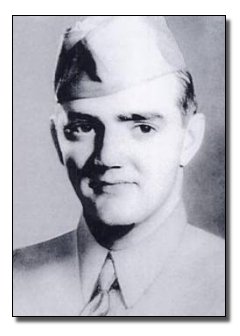
On the day he died, Baker found himself facing down an INSANE banzai charge of roughly 5,000 Japanese infantrymen flying bayonet-first out of the jungles and screaming, "Long Live the Emperor" Imperial Space Marine-style. Seeing the enemy closing in on three sides, Baker simply cracked his knuckles, swore under his breath and changed a clip into his weapon.
The initial wave left Baker seriously wounded by enemy rifle fire, but he refused to run or back down or show any emotion other than anger. He stood his ground, firing like crazy with any weapons he could get his hands on, sometimes from as close as point-blank range. When he ran out of bullets, he Hulked up (Banner or Hogan, your choice) and beat off the attack with his hands, an admittedly ballsy move that left him even more fucked up.

Why not both?
His weapon was smashed and he was bleeding profusely from a number of gaping wounds when some of his men came up and started carrying him from the battlefield. By this time the perimeter was buckling, the fight was lost and the Americans were falling back to regroup, but Baker didn't give a shit. He knew that dragging his half-dead ass along the ground was only slowing down the withdrawal, so he told his men to prop him up against a tree facing the enemy. He borrowed a Colt 1911, made sure that it had a full eight-round clip and told his men to get the fuck out of there while he bought them some time.

Standard issue Colt 1911. Not standard issue: being super hardcore.
When the final American advance pushed forward and captured Saipan later that same month, they found Sergeant Baker's body propped up against the tree, facing his enemies right where they'd left him. The eight rounds they'd left him with meanwhile, were now in the eight dead Japanese soldiers scattered before him.
Further Reading:
Full Medal of Honor CitationGoldberg, Harold J. D-Day in the Pacific. Indiana Univ. Press, 2007.
Sinton, Starr, and Robert Hargis. World War II Medal of Honor Recipients. Osprey, 2003.
Ben Thompson has spent the past five and a half years documenting some of the greatest warriors in history on his website, Badass of the Week. To promote the release of his new book BADASS, he's gone out and found the most insane stories of people who refused to back down right up until (and in some cases, after) their hearts stopped.